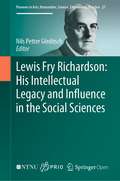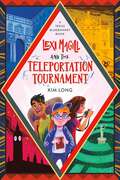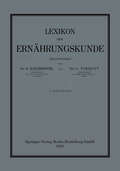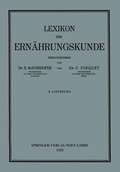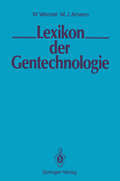- Table View
- List View
Leviathan
by Philip HoareThis edition does not include illustrations. The story of a man’s obsession with whales, which takes him on a personal, historical and biographical journey – from his childhood to his fascination with Moby-Dick and his excursions whale-watching.
Leviathan and the Air-Pump: Hobbes, Boyle, and the Experimental Life
by Steven Shapin Simon SchafferLeviathan and the Air-Pump examines the conflicts over the value and propriety of experimental methods between two major seventeenth-century thinkers: Thomas Hobbes, author of the political treatise Leviathan and vehement critic of systematic experimentation in natural philosophy, and Robert Boyle, mechanical philosopher and owner of the newly invented air-pump. The issues at stake in their disputes ranged from the physical integrity of the air-pump to the intellectual integrity of the knowledge it might yield. Both Boyle and Hobbes were looking for ways of establishing knowledge that did not decay into ad hominem attacks and political division. Boyle proposed the experiment as cure. He argued that facts should be manufactured by machines like the air-pump so that gentlemen could witness the experiments and produce knowledge that everyone agreed on. Hobbes, by contrast, looked for natural law and viewed experiments as the artificial, unreliable products of an exclusive guild. The new approaches taken in Leviathan and the Air-Pump have been enormously influential on historical studies of science. Shapin and Schaffer found a moment of scientific revolution and showed how key scientific givens--facts, interpretations, experiment, truth--were fundamental to a new political order. Shapin and Schaffer were also innovative in their ethnographic approach. Attempting to understand the work habits, rituals, and social structures of a remote, unfamiliar group, they argued that politics were tied up in what scientists did, rather than what they said. Steven Shapin and Simon Schaffer use the confrontation between Hobbes and Boyle as a way of understanding what was at stake in the early history of scientific experimentation. They describe the protagonists' divergent views of natural knowledge, and situate the Hobbes-Boyle disputes within contemporary debates over the role of intellectuals in public life and the problems of social order and assent in Restoration England. In a new introduction, the authors describe how science and its social context were understood when this book was first published, and how the study of the history of science has changed since then.
Leviathan and the Air-Pump: Hobbes, Boyle, and the Experimental Life
by Steven Shapin Simon SchafferLeviathan and the Air-Pump examines the conflicts over the value and propriety of experimental methods between two major seventeenth-century thinkers: Thomas Hobbes, author of the political treatise Leviathan and vehement critic of systematic experimentation in natural philosophy, and Robert Boyle, mechanical philosopher and owner of the newly invented air-pump. The issues at stake in their disputes ranged from the physical integrity of the air-pump to the intellectual integrity of the knowledge it might yield. Both Boyle and Hobbes were looking for ways of establishing knowledge that did not decay into ad hominem attacks and political division. Boyle proposed the experiment as cure. He argued that facts should be manufactured by machines like the air-pump so that gentlemen could witness the experiments and produce knowledge that everyone agreed on. Hobbes, by contrast, looked for natural law and viewed experiments as the artificial, unreliable products of an exclusive guild. The new approaches taken in Leviathan and the Air-Pump have been enormously influential on historical studies of science. Shapin and Schaffer found a moment of scientific revolution and showed how key scientific givens--facts, interpretations, experiment, truth--were fundamental to a new political order. Shapin and Schaffer were also innovative in their ethnographic approach. Attempting to understand the work habits, rituals, and social structures of a remote, unfamiliar group, they argued that politics were tied up in what scientists did, rather than what they said. Steven Shapin and Simon Schaffer use the confrontation between Hobbes and Boyle as a way of understanding what was at stake in the early history of scientific experimentation. They describe the protagonists' divergent views of natural knowledge, and situate the Hobbes-Boyle disputes within contemporary debates over the role of intellectuals in public life and the problems of social order and assent in Restoration England. In a new introduction, the authors describe how science and its social context were understood when this book was first published, and how the study of the history of science has changed since then.
Levulinic Acid: A Sustainable Platform Chemical for Value-Added Products
by Ana Lúcia de Lima Claudio J. Mota Daniella R. Fernandes Bianca P. PintoLEVULINIC ACID An essential overview of this renewable platform chemical with growing commercial applications Use of fossil fuels and their derivatives has been one of the major drivers of climate change. This ongoing crisis has driven a global search for biofuels and biomass-derived chemicals which can serve as the basis for sustainable and renewable industry. One such ‘platform molecule’ is levulinic acid, whose derivatives are increasingly replacing traditional fossil-derived chemicals. The importance of levulinic acid for renewable industry is therefore only growing. Levulinic Acid: A Sustainable Platform Chemical for Value-Added Products provides a book-length introduction to this chemical and its derivatives, like the levulinates, for which applications include fuel additives, food and cosmetic preservatives, flavors, solvents, and more. The book surveys the production routes and necessary technologies involved in the production of levulinic acid, as well as its current and potential applications and typical chemical reactions. It provides a critical introduction to a potentially rich source of alternative industrial material. Levulinic Acid readers will also find: Production routes from different biomass materials Treatment of both organic and inorganic levulinates Extensive discussion of levulinic acid hydrogenation Other derivatives formed upon reaction at the keto-functionality Levulinic Acid is the first book on this subject, ideal for researchers and industry professionals in green chemistry and sustainable/renewable production, as well as regulators and policymakers with a focus on the relevant industries.
Levulinic Acid: A Sustainable Platform Chemical for Value-Added Products
by Ana Lúcia de Lima Claudio J. Mota Daniella R. Fernandes Bianca P. PintoLEVULINIC ACID An essential overview of this renewable platform chemical with growing commercial applications Use of fossil fuels and their derivatives has been one of the major drivers of climate change. This ongoing crisis has driven a global search for biofuels and biomass-derived chemicals which can serve as the basis for sustainable and renewable industry. One such ‘platform molecule’ is levulinic acid, whose derivatives are increasingly replacing traditional fossil-derived chemicals. The importance of levulinic acid for renewable industry is therefore only growing. Levulinic Acid: A Sustainable Platform Chemical for Value-Added Products provides a book-length introduction to this chemical and its derivatives, like the levulinates, for which applications include fuel additives, food and cosmetic preservatives, flavors, solvents, and more. The book surveys the production routes and necessary technologies involved in the production of levulinic acid, as well as its current and potential applications and typical chemical reactions. It provides a critical introduction to a potentially rich source of alternative industrial material. Levulinic Acid readers will also find: Production routes from different biomass materials Treatment of both organic and inorganic levulinates Extensive discussion of levulinic acid hydrogenation Other derivatives formed upon reaction at the keto-functionality Levulinic Acid is the first book on this subject, ideal for researchers and industry professionals in green chemistry and sustainable/renewable production, as well as regulators and policymakers with a focus on the relevant industries.
Lévy Statistics and Spin Glass Behavior in Random Lasers
by Anderson S. L. Gomes André L. Moura Cid B. de Araújo Ernesto P. RaposoThis book could not have been timelier. It describes a multidisciplinary experimental work reported in the literature from 2015 to 2022, supported by a theoretical proposal from 2006, exploiting random lasers and random fiber lasers as a photonic platform to perform statistical physics, as Lévy-like statistics and extreme events, as well as complex systems, including turbulence, replica symmetry breaking (RSB) and Floquet states. Most of the theoretical grounds for these subjects date back to the 1970s. Of particular relevance for the timing for this book is the fact that two of the Nobel Prize winners of 2021 have their work connected through the experimental and theoretical work exploiting random lasers. In fact, the very first demonstration of RSB, a theory proposed by Giorgio Parisi, one of the 2021 Nobel winners, was first experimentally demonstrated in 2015 using random lasers. The scope of the book relies on the description of the already vast literature starting in 2006, but with an experimental explosion since 2015. The book describes the basis of random lasers and random fibers, theoretical background and connection between magnetism and photonics related to RSB, and theoretical backgrounds for experiments in Lévy statistics, turbulence, and Floquet states. The contributors are from three of the groups with most contributions in the field.
Lévy Statistics and Spin Glass Behavior in Random Lasers
This book could not have been timelier. It describes a multidisciplinary experimental work reported in the literature from 2015 to 2022, supported by a theoretical proposal from 2006, exploiting random lasers and random fiber lasers as a photonic platform to perform statistical physics, as Lévy-like statistics and extreme events, as well as complex systems, including turbulence, replica symmetry breaking (RSB) and Floquet states. Most of the theoretical grounds for these subjects date back to the 1970s. Of particular relevance for the timing for this book is the fact that two of the Nobel Prize winners of 2021 have their work connected through the experimental and theoretical work exploiting random lasers. In fact, the very first demonstration of RSB, a theory proposed by Giorgio Parisi, one of the 2021 Nobel winners, was first experimentally demonstrated in 2015 using random lasers. The scope of the book relies on the description of the already vast literature starting in 2006, but with an experimental explosion since 2015. The book describes the basis of random lasers and random fibers, theoretical background and connection between magnetism and photonics related to RSB, and theoretical backgrounds for experiments in Lévy statistics, turbulence, and Floquet states. The contributors are from three of the groups with most contributions in the field.
Lewis and Clark: Weather and Climate Data from the Expedition Journals
by Vernon PrestonBy Terry Nathans he weather and climate of the trans-Mississippi west was virtually unknown at the begin- Tning of the nineteenth century. This changed dramatically shortly after the Louisiana P- chase was signed in 1803, which set the stage for acquiring the first systematic weather measurements of the trans-Mississippi west. The framework for obtaining these measurements was outlined in the now famous June 20, 1803 letter from President Thomas Jefferson to his protégé and personal secretary, Captain Meriwether Lewis. In that letter, Jefferson instructed Lewis to plan and carry out an overland expedition to the Pacific Ocean for the purposes of commerce, and to observe and record a broad range of natural history subjects, including the …climate, as characterised by the thermometer, by the proportion of rainy, cloudy & clear days, by lightning, hail, snow, ice, by the access & recess of frost, by the winds prevailing at different s- sons, the dates at which particular plants put forth or lose their flower, or leaf… (Jackson 1978, p. 63). Jefferson’s instructions to Lewis, which were part of his decades-long ambition of laun- ing an expedition to explore the interior of North America, were made at the threshold of what Fleming (1990) has called the “expanding horizons” in meteorology. During this period, more reliable meteorological instruments began to emerge allowing for a more comprehensive and systematic acquisition of weather data.
Lewis Base Catalysis in Organic Synthesis
by Edwin Vedejs Scott E. DenmarkThis three-volume set represents the first comprehensive coverage of the rapidly expanding field of Lewis base catalysis that has attracted enormous attention in recent years. Lewis base catalysis is a conceptually novel paradigm that encompasses an extremely wide variety of preparatively useful transformations and is particularly effective for enantioselectively constructing new stereogenic centers. As electron-pair donors, Lewis bases can influence the rate and stereochemical course of myriad synthetic organic reactions. The book presents the conceptual/mechanistic principles that underlie Lewis base catalysis, and then builds upon that foundation with a thorough presentation of many different reaction types. And last but not least, the editors, Prof. Edwin Vedejs and Prof. Scott E. Denmark, are without doubt the leaders in this emerging field and have compiled high quality contributions from an impressive collection of international experts.
Lewis Base Catalysis in Organic Synthesis
by Edwin Vedejs Scott E. DenmarkThis three-volume set represents the first comprehensive coverage of the rapidly expanding field of Lewis base catalysis that has attracted enormous attention in recent years. Lewis base catalysis is a conceptually novel paradigm that encompasses an extremely wide variety of preparatively useful transformations and is particularly effective for enantioselectively constructing new stereogenic centers. As electron-pair donors, Lewis bases can influence the rate and stereochemical course of myriad synthetic organic reactions. The book presents the conceptual/mechanistic principles that underlie Lewis base catalysis, and then builds upon that foundation with a thorough presentation of many different reaction types. And last but not least, the editors, Prof. Edwin Vedejs and Prof. Scott E. Denmark, are without doubt the leaders in this emerging field and have compiled high quality contributions from an impressive collection of international experts.
Lewis Basicity and Affinity Scales: Data and Measurement
by Christian Laurence Jean-François GalThe Lewis concept of acids and bases is discussed in every general, organic and inorganic chemistry textbook. This is usually just a descriptive treatment, as it is not possible to devise a single numerical scale suitable for all occasions. However quantitative Lewis acid-base chemistry can be developed by compiling reaction-specific basicity scales which can be used in specific branches of chemistry and biochemistry. Lewis Basicity and Affinity Scales: Data and Measurementbrings together for the first time a comprehensive range of Lewis basicity/affinity data in one volume. More than 2400 equilibrium constants of acid-base reactions, 1500 complexation enthalpies, and nearly 2000 infrared and ultraviolet shifts upon complexation are gathered together in 25 thermodynamic and spectroscopic scales of basicity and/or affinity. For each scale, the definition, the method of measurement, an exhaustive database, and a critical discussion are given. All the data have been critically examined; some have been re-measured; literature gaps have been filled by original measurements; and each scale has been made homogeneous. This collection of data will enable experimental chemists to better understand and predict the numerous chemical, physical and biological properties that depend upon Lewis basicity. Chemometricians will be able to apply their methods to the data matrices constructed from this book in order to identify the factors which influence basicity and basicity-dependent properties. In addition, measured experimental basicities and affinities are essential to computational chemists for the validation, calibration and establishment of reliable computational methods for quantifying and explaining intermolecular forces and the chemical bond. Lewis Basicity and Affinity Scales: Data and Measurement is an essential single-source desktop reference for research scientists, engineers, and students in academia, research institutes and industry, in all areas of chemistry from fundamental to applied research. "The book is a noteworthy piece of work and represents a timely and vast accumulation of knowledge regarding Lewis bases that brings together accurate thermodynamic and spectroscopic data on typical reference Lewis acids. As such, it should serve as a useful and general guide to basicity." J. AM. CHEM. SOC. 2011, 133, 642
Lewis Fry Richardson: His Intellectual Legacy And Influence In The Social Sciences (Pioneers in Arts, Humanities, Science, Engineering, Practice #27)
by Nils Petter GleditschThis is an open access book. Lewis F Richardson (1981-1953), a physicist by training, was a pioneer in meteorology and peace research and remains a towering presence in both fields. This edited volume reviews his work and assesses its influence in the social sciences, notably his work on arms races and their consequences, mathematical models, the size distribution of wars, and geographical features of conflict. It contains brief bibliographies of his main publications and of articles and books written about Richardson and his work and discusses his continuing influence in peace research and international relations as well as his attitude to the ethical responsibilities of a scientist. It will be of interest to a wide range of scholars. This book includes 11 chapters written by Nils Petter Gleditsch, Dina A Zinnes, Ron Smith, Paul F Diehl, Kelly Kadera, Mark Crescenzi, Michael D Ward, Kristian Skrede Gleditsch, Nils B Weidmann, Jürgen Scheffran, Niall MacKay, Aaron Clauset, Michael Spagat and Stijn van Weezel.Lewis F Richardson occupied an important position in two academic fields as different as meteorology and peace research, with academic prizes awarded in both disciplines.In peace research, he pioneered the use of mathematical models and the meticulous compilation of databases for empirical research.As a quaker and pacifist, he refused to work in preparations for war, paid a heavy prize in terms of his career, and (at least in the social sciences) was fully recognized as a pioneering scholar only posthumously with the publication of two major books.Lewis Fry Richardson is one of the 20th century’s greatest but least appreciated thinkers—a creative physicist, psychologist, meteorologist, applied mathematician, historian, pacifist, statistician, and witty stylist. If you’ve heard of weather prediction, chaos, fractals, cliometrics, peace science, big data, thick tails, or black swans, then you have benefited from Richardson’s prescience in bringing unruly phenomena into the ambit of scientific understanding. Richardson’s ideas continue to be relevant today, and this collection is a superb retrospective on this brilliant and lovable man.Steven Pinker, Johnstone Professor, Harvard University, and the author of The Better Angels of Our Nature and Enlightenment Now
Lewis Swift: Celebrated Comet Hunter and the People's Astronomer (Historical & Cultural Astronomy)
by Gary W. KronkThis biography covers the life of Lewis Swift (1820-1913), who discovered 13 comets and nearly 1,200 other deep sky objects. All 13 comets found by Swift now bear his name, including three periodic comets with periods of 6 years (11P/Tempel-Swift-LINEAR), 9 years (64P/Swift-Gehrels), and 133 years (109P/Swift-Tuttle).Swift's enthusiasm and success as an amateur astronomer helped make him famous in the United States. With the help of others, Swift was able to buy a 16-inch refractor, the third largest telescope in the United States at the time. Hulbert Harrington Warner built "Warner Observatory" to house this telescope. As a prolific writer and lecturer, Swift's stories appeared in newspapers and magazines, while his lectures showed that he was able to explain anything in a way that everyone could understand. When Warner went broke during the "Panic of 1893," Swift was forced to leave his home. Almost two dozen invitations arrived from around the United States asking him to bring his telescope to their city, and he eventually accepted the invitation of Californian Thaddeus Sobieski Constantin Lowe. This book highlights Swift's valuable contributions to astronomy before failing eyesight forced him to give up this profession. In addition to detailing Swift's life, biographical material is also provided for a number of individuals who were influenced by Swift. This includes his son, Edward, who was discovering deep sky objects as a teenager.
Lexi Magill and the Teleportation Tournament
by Kim LongFor fans of The Amazing Race, Lexi Magill and the Teleportation Tournament is the perfect adventure for middle grade readers who like scavenger hunts and puzzle-solving.Twelve-year-old physics whiz Lexi Magill won't let anything stop her from winning Wisconsin's Teleportation Tournament--the annual competition where teams teleport around the world to solve science-based puzzles. She needs the prize money if she wants to re-enroll in the science academy her parents can no longer afford. Added bonus: she'll be able to reconnect with her best friend Haley.But Lexi's two teammates put a wrench in her plans. When one misreads a clue that lands the team in a castle in Germany, and the other loses her teleportation medallion in Poland, Lexi wonders what she's gotten herself into. Struggling to keep her team under control as the race rages on, Lexi not only has to figure out how to get back on course (literally), but she must decide how far she's willing to go to win, and who her real friends are. With riddles to solve and messages to decode, this interactive read won't disappoint!
Lexi Magill and the Teleportation Tournament
by Kim LongFor fans of The Amazing Race, Lexi Magill and the Teleportation Tournament is the perfect adventure for middle grade readers who like scavenger hunts and puzzle-solving.Twelve-year-old physics whiz Lexi Magill won't let anything stop her from winning Wisconsin's Teleportation Tournament--the annual competition where teams teleport around the world to solve science-based puzzles. She needs the prize money if she wants to re-enroll in the science academy her parents can no longer afford. Added bonus: she'll be able to reconnect with her best friend Haley.But Lexi's two teammates put a wrench in her plans. When one misreads a clue that lands the team in a castle in Germany, and the other loses her teleportation medallion in Poland, Lexi wonders what she's gotten herself into. Struggling to keep her team under control as the race rages on, Lexi not only has to figure out how to get back on course (literally), but she must decide how far she's willing to go to win, and who her real friends are. With riddles to solve and messages to decode, this interactive read won't disappoint!
Lexical Ambiguity Resolution: Perspective from Psycholinguistics, Neuropsychology and Artificial Intelligence
by Steven L. Small, Garrison W. Cottrell, Michael K. TanenhausThe most frequently used words in English are highly ambiguous; for example, Webster's Ninth New Collegiate Dictionary lists 94 meanings for the word "run" as a verb alone. Yet people rarely notice this ambiguity. Solving this puzzle has commanded the efforts of cognitive scientists for many years. The solution most often identified is "context": we use the context of utterance to determine the proper meanings of words and sentences. The problem then becomes specifying the nature of context and how it interacts with the rest of an understanding system. The difficulty becomes especially apparent in the attempt to write a computer program to understand natural language. Lexical ambiguity resolution (LAR), then, is one of the central problems in natural language and computational semantics research. A collection of the best research on LAR available, this volume offers eighteen original papers by leading scientists. Part I, Computer Models, describes nine attempts to discover the processes necessary for disambiguation by implementing programs to do the job. Part II, Empirical Studies, goes into the laboratory setting to examine the nature of the human disambiguation mechanism and the structure of ambiguity itself. A primary goal of this volume is to propose a cognitive science perspective arising out of the conjunction of work and approaches from neuropsychology, psycholinguistics, and artificial intelligence--thereby encouraging a closer cooperation and collaboration among these fields. Lexical Ambiguity Resolution is a valuable and accessible source book for students and cognitive scientists in AI, psycholinguistics, neuropsychology, or theoretical linguistics.
Lexicon of Pulse Crops
by Aleksandar MikićLexicon of Pulse Crops integrates botanical and linguistic data to analyze and interpret the grain legume significance from the earliest archaeological and written records until the present day. Aimed at both agronomic and linguistic research communities, this book presents a database containing 9,500 common names in more than 900 languages and dialects of all ethnolinguistic families, denoting more than 1,100 botanical taxa of 14 selected pulse crop genera and species. The book begins with overviews of the world’s economically most important grain legume crops and their uncultivated relatives, as well as the world’s language families with their inner structure, including both extinct and living members. The main section of the text presents 14 specialized book chapters covering Arachis, Cajanus, Cicer, Ervum, Faba, Glycine, Lablab, Lathyrus, Lens, Lupinus, Phaseolus, Pisum, Vicia, and Vigna. They provide the reader with extensive lists of the botanically accepted species and subtaxa and surveys lexicological abundance in all world’s ethnolinguistic families, comprising extinct and living as well as natural and constructed languages, while the vernacular names for the most significant taxa are presented in comprehensive tables. Each of these chapters also presents the existing etymologies and novel approaches to deciphering the origins of common names, accompanied by one original color plate depicting possible root evolutions in the form of corresponding pulse crop plants.
Lexicon of Pulse Crops
by Aleksandar MikićLexicon of Pulse Crops integrates botanical and linguistic data to analyze and interpret the grain legume significance from the earliest archaeological and written records until the present day. Aimed at both agronomic and linguistic research communities, this book presents a database containing 9,500 common names in more than 900 languages and dialects of all ethnolinguistic families, denoting more than 1,100 botanical taxa of 14 selected pulse crop genera and species. The book begins with overviews of the world’s economically most important grain legume crops and their uncultivated relatives, as well as the world’s language families with their inner structure, including both extinct and living members. The main section of the text presents 14 specialized book chapters covering Arachis, Cajanus, Cicer, Ervum, Faba, Glycine, Lablab, Lathyrus, Lens, Lupinus, Phaseolus, Pisum, Vicia, and Vigna. They provide the reader with extensive lists of the botanically accepted species and subtaxa and surveys lexicological abundance in all world’s ethnolinguistic families, comprising extinct and living as well as natural and constructed languages, while the vernacular names for the most significant taxa are presented in comprehensive tables. Each of these chapters also presents the existing etymologies and novel approaches to deciphering the origins of common names, accompanied by one original color plate depicting possible root evolutions in the form of corresponding pulse crop plants.
Lexikon der Arzneipflanzen und Drogen
by Matthias F. Melzig Karl HillerDas Lexikon der Arzneipflanzen und Drogen gibt einen umfassenden Überblick über die heute wie auch in früherer Zeit verwendeten Arzneidrogen. Die 3. Auflage des Lexikons enthält ca. 480 neue Artikel inkl. Strukturformeln der Drogeninhaltsstoffe und wurde um das Gebiet der Nahrungsergänzungsmittel erweitert. In den einzelnen Artikeln wird auf Drogen europäischer Arzneibücher hingewiesen sowie auf solche, die in der europäischen, afrikanischen, amerikanischen oder asiatischen traditionellen Medizin eingesetzt werden. Die Anordnung der Stichwörter erfolgt alphabetisch nach den wissenschaftlichen Namen der Pflanzen/Tiere/Mikroorganismen und beinhaltet Vorkommen bzw. Herkunft der Drogen, Inhaltsstoffe, therapeutische Nutzung bzw. Anwendung in der Volksheilkunde und Homöopathie. Als umfassendes Nachschlagewerk für alle Fragestellungen zu Arzneidrogen wendet sich das Lexikon an Wissenschaftler und Studenten der Pharmazie, Biologie, Medizin, Chemie sowie an Ärzte für Naturheilverfahren, Apotheker, Heilpraktiker und an Mitarbeiter in der Industrie.
Lexikon der Ernährungskunde
by E. Mayerhofer C. PirquetDieser Buchtitel ist Teil des Digitalisierungsprojekts Springer Book Archives mit Publikationen, die seit den Anfängen des Verlags von 1842 erschienen sind. Der Verlag stellt mit diesem Archiv Quellen für die historische wie auch die disziplingeschichtliche Forschung zur Verfügung, die jeweils im historischen Kontext betrachtet werden müssen. Dieser Titel erschien in der Zeit vor 1945 und wird daher in seiner zeittypischen politisch-ideologischen Ausrichtung vom Verlag nicht beworben.
Lexikon der Ernährungskunde
by E. Mayerhofer C. PirquetDieser Buchtitel ist Teil des Digitalisierungsprojekts Springer Book Archives mit Publikationen, die seit den Anfängen des Verlags von 1842 erschienen sind. Der Verlag stellt mit diesem Archiv Quellen für die historische wie auch die disziplingeschichtliche Forschung zur Verfügung, die jeweils im historischen Kontext betrachtet werden müssen. Dieser Titel erschien in der Zeit vor 1945 und wird daher in seiner zeittypischen politisch-ideologischen Ausrichtung vom Verlag nicht beworben.
Lexikon der Ernährungskunde: 4. Lieferung
by Ernst Mayerhofer Clemens Pirquet von CesenaticoDieser Buchtitel ist Teil des Digitalisierungsprojekts Springer Book Archives mit Publikationen, die seit den Anfängen des Verlags von 1842 erschienen sind. Der Verlag stellt mit diesem Archiv Quellen für die historische wie auch die disziplingeschichtliche Forschung zur Verfügung, die jeweils im historischen Kontext betrachtet werden müssen. Dieser Titel erschien in der Zeit vor 1945 und wird daher in seiner zeittypischen politisch-ideologischen Ausrichtung vom Verlag nicht beworben.
Lexikon der Ernährungskunde
by Ernst Mayerhofer Clemens Pirquet von CesenaticoDieser Buchtitel ist Teil des Digitalisierungsprojekts Springer Book Archives mit Publikationen, die seit den Anfängen des Verlags von 1842 erschienen sind. Der Verlag stellt mit diesem Archiv Quellen für die historische wie auch die disziplingeschichtliche Forschung zur Verfügung, die jeweils im historischen Kontext betrachtet werden müssen. Dieser Titel erschien in der Zeit vor 1945 und wird daher in seiner zeittypischen politisch-ideologischen Ausrichtung vom Verlag nicht beworben.







